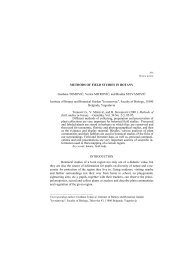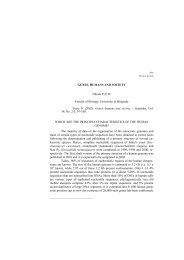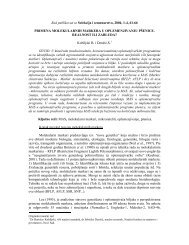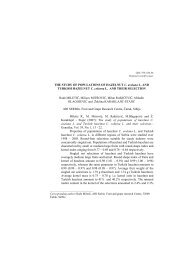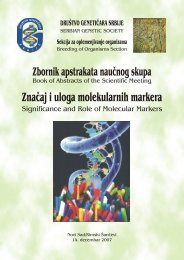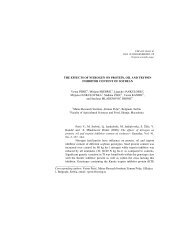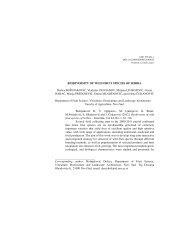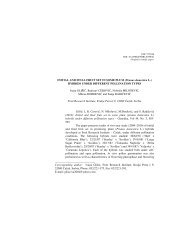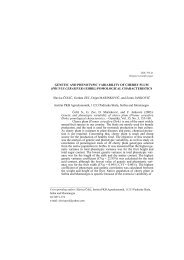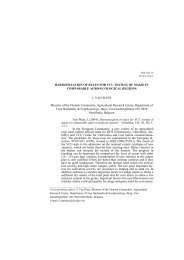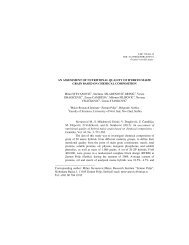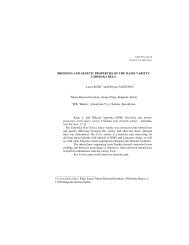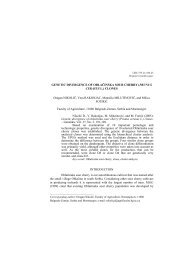Zbornik - Društvo genetičara Srbije
Zbornik - Društvo genetičara Srbije
Zbornik - Društvo genetičara Srbije
Create successful ePaper yourself
Turn your PDF publications into a flip-book with our unique Google optimized e-Paper software.
V-Usm-14 ZBORNIK ABSTRAKATA III KONGRESA GENETIÈARA SRBIJE 197<br />
Subotica, 30. novembar - 4. decembar 2004.<br />
DETEKCIJA MINIMALNE REZIDUALNE BOLESTI KOD BOLESNIKA SA<br />
HRONIÈNOM MIJELOIDNOM LEUKEMIJOM (CML) LEÈENIH IMATINIB<br />
MESYLATOM<br />
Anka Radoviæ, Biljana Todoriæ-ivanoviæ, Milica Strnad, Dragana Stamatoviæ,<br />
Koviljka Krtolica 1 i Z. Magiæ 1<br />
Vojnomedicinska Akademija, Beograd<br />
1<br />
Institut za nuklearne nauke «Vinèa», Beograd<br />
Detekcija i praæenje minimalne rezidualne bolesti (MRB), zaostalih malignih æelija<br />
nakon terapije, postalo je jedno od najvanijih zadataka kad su u pitanju bolesnici sa<br />
CML leèeni imatinib mesylatom. Postizanje kompletne hematološke i citogenetske<br />
remisije kod odreðenog broja bolesnika sa CML a zatim relaps bolesti objašnjavaju se<br />
upravo postojanjem malog broja malignih æelija rezistentnih na primenjenu terapiju.<br />
Zbog toga njihovo otkrivanje daje vanu informaciju o efektu terapije kao i moguænost<br />
da terapeut pravovremeno odreaguje pre nego što doðe do relapsa bolesti. RT-PCR<br />
tehnika se pokazala kao najsenzitivnija, omoguæujuæi detekciju jedne maligne æelije na<br />
10 5-106normalnih. Kao pozitivni marker za detekciju MRB koristi se BCR-ABL fuzioni<br />
gen koji ima kljuènu ulogu u patogenezi CML. Detekcija prisustva minimalne rezidualne<br />
bolesti bolesnika sa CML koji su postigli kompletan citogenetski odgovor (0% æelija sa<br />
Philadelfija hromozomom) nakon primenjene terapije imatinib mesylatom. Prisustvo<br />
rezidualnih æelija koje eksprimiraju BCR-ABL himerni gen analizirano je u uzorcima<br />
periferne krvi kod pet bolesnika (od dvadeset na imatinib terapiji) koji su postigli<br />
kompletan citogenetski odgovor. Detekcija je vršena RT-PCR i «nested» RT-PCR<br />
tehnikom. Kod tri bolesnika RT-PCR tehnikom detektovano je prisustvo rearanmana<br />
b3a2 tipa. Kod dva bolesnika je po dobijanju negativnog rezultata nakon RT-PCR<br />
tehnike primenjena «nested» RT-PCRmetoda.<br />
Ovom metodom utvrðeno je prisustvo BCR-ABL rearanmana i to kod jednog bolesnika<br />
b3a2 tip a kod drugog b2a2 tip.<br />
DETECTION OF MINIMAL RESIDUAL DISEASE IN PATIENTS WITH<br />
CHRONIC MYELOGENOUS LEUKEMIA (CML) TREATED WITH<br />
IMATINIB MESYLATE<br />
Detection and monitoring of minimal residual disease (MRD), malignant cells remained<br />
after the therapy, has become one of the most important tasks when it comes to CML patients<br />
treated with imatinib mesylate. The fact that certain number of patients suffering<br />
from CML first achieve complete hematologic and cytogenetic remission which is afterwards<br />
followed by relapse of disease could actually be clarified through the existence of<br />
small number of malignant cells that are resistant to the applied therapy. Therefore, detection<br />
of these cells will provide important information on the effect of therapy as well as offer<br />
a therapist an opportunity to react promptly before the relapse of disease takes place.<br />
RT-PCR technique proved to be the most sensitive one enabling the detection of one malignant<br />
cell in 10 5 -10 6 normal ones. BCR-ABL fusion gene that has a crucial role in<br />
pathogenesis of CML is used as positive marker for detection of MRD. Detection of the<br />
presence of minimal residual disease in CML patients who after the application of imatinib<br />
mesylate therapy reached complete cytogenetic response (0%cells with Philadelphia chromosome).<br />
Presence of residual cells that express BCR-ABL chimerical gene was analysed<br />
in the samples of peripheral blood from five patients (out of twenty undergoing imatinib<br />
therapy) who had reached complete cytogenetic response. Detection was performed by the<br />
means of RT-PCR and nested RT-PCR technique. In three patients b3a2 rearrangement<br />
type was detected by RT-PCR tehnique. In two remaining patients after negative RT-PCR<br />
results nested RT-PCR was applied. By this method BCR-ABL rearrangement was detected<br />
in both patients, one of them having b3a2 type and the other b2a2 type.



